Drawings by: Alesha Garand
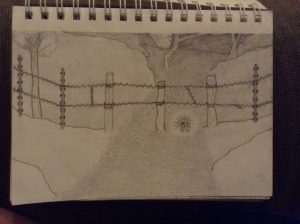
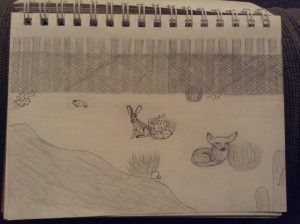
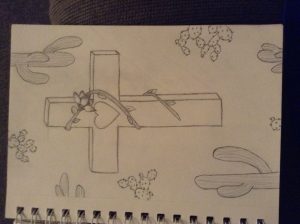


By Ellie
Drawings by: Alesha Garand





By Laurie
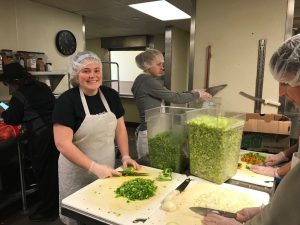
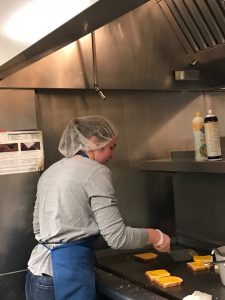
March 16th
Today we went to the Rescue Mission and got to explore Tacoma. At the rescue mission we helped make lunch, and prepped for dinner and the next day’s breakfast. This included chopping a lot of onions, Cayley making 100 grilled cheeses, and Cayley and Charlie serving lunch to around 40 people that live and work at the Rescue Mission. This was extremely different from the rest of the week in which we did a lot of construction work.
After we volunteered and ate lunch we went to Point Defiance Park and explored. First we went to The Living History Museum which is a model of Fort Nisqually. This was very cool! We then went to Owen’s Beach which was awesome because we got a beautiful view of the Sound, and saw our fair share of dogs. This was quite relaxing in comparison to the rest of the week and gave us a very different perspective of Tacoma.
After this we went to a local restaurant and had a cool send off party that Habitat threw for us. It was awesome to see how thankful Habitat was for our service throughout this immersion.
Charlie
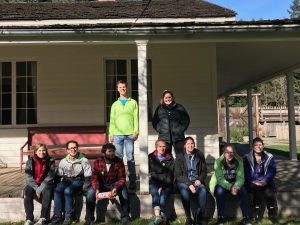
By Laurie
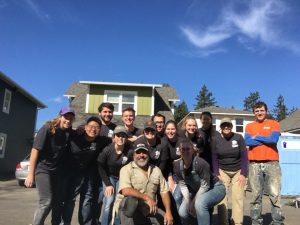 March 15, 2018
March 15, 2018
It was an odd feeling, knowing it was our last day on site. It felt as if we had just started working when we rolled up to the work site for the last time. The majority of our crew was put to work on lot 1, which is the house that is being dedicated on Saturday, so it was pretty important to finish that house up. I’m still in awe of how much Habitat does. Looking around the site, from a nearly finished house to one with its bones barely in place, it really put into perspective how much Habitat does. Beyond the houses, the people I met on site and talked with made this immersion so much more. I find myself already missing the friendly faces of those who helped us, taught us, and fed us throughout this week, and their energy and spirit are things that I hope to carry with me even after we return to Portland. Although I can only really speak for myself, I think that everyone feels a bit of sadness now that our time with Habitat has officially come to an end. Our community in this immersion has definitely grown together and I am forever grateful for this time together. Moving forward, this week has taught me to value the people that surround me and to take pride in my community. I am a little sad that this time has come to an end, but it has given me the tools to move forward in my everyday life to continue to work in my community.
-Genevieve
By Tshombe
March 15, 2018
One thing that really stood out to us today was learning about the sanctuary movement and the role of churches. We visited the Southside Presbyterian church, which is rooted in the sanctuary movement of the 1980’s and is a leader in the new current sanctuary movement. It continues to help people in the community.
We heard a story of a member of the Tucson community that they recently helped by providing sanctuary. Her name was Rosa, she is a mother of two and stayed there for a year and 4 months because of her immigration status. She was in such a difficult situation that she had to resort to going into sanctuary which is still very much like a prison because she is restricted to one location with limited access to loved ones.
This was very powerful and helped us to see the true magnitude of the sanctuary movement.
By: Karina Diaz and Melissa Olivera
By Laurie
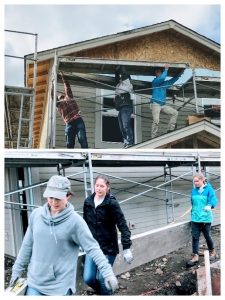 Today was our second day on site.
Today was our second day on site.
Most of us spent the day working on the one house (out of 7 that are on site) that is supposed to be finished this Saturday. All of the boys except Jumel were able to go on the roof today – which was definitely a highlight for them.
Overall, today was a very joy-filled day. Everyone has been laughing throughout the day and we’ve been able to have fun, while also continuing to make progress on the houses.
Our group as a whole was starting to connect and develop a real sense of teamwork. We also started to get more comfortable with the workers on site. We all have been enjoying our experience with Habitat and have noticed the hospitality that they have shown us.
I know that we have been making a contribution, but to me the work that I’m doing seems very small in comparison to the entirety of effort and work that goes into building a house. However, all of the workers and the people from the Habitat community have expressed their genuine appreciation for the time we are giving to help build these homes.
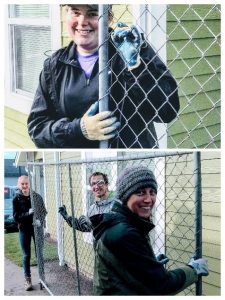 It definitely puts things into perspective – something that seems so insignificant to me, may make immeasurable differences to other people.
It definitely puts things into perspective – something that seems so insignificant to me, may make immeasurable differences to other people.
In case people were curious – after our work day is over, we hit the showers then headed back to Bethlehem Lutheran Church, where we have been privileged to stay while on the Collegiate Challenge.
We had some dinner (tonight we had more than plenty of pasta) and generally play a lot of card games – which can get competitive from time to time. The games have served as a great community builder and have resulted in numerous laughs.
Cayley
By Laurie
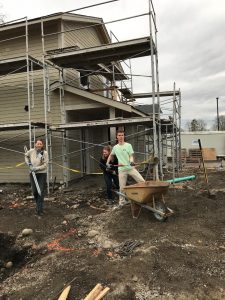 Today was our first day onsite with Habitat for Humanity at North Tillicum. We all showed up eager and excited to start working on a new house, or as we found out today, houses. We met our leader Nick and he showed us around a lot of seven different houses, which was so cool because each is currently at a different stage in construction.
Today was our first day onsite with Habitat for Humanity at North Tillicum. We all showed up eager and excited to start working on a new house, or as we found out today, houses. We met our leader Nick and he showed us around a lot of seven different houses, which was so cool because each is currently at a different stage in construction.
Gen and Charlie got to do electrical work while the rest of us helped clean up and move materials around the lot. A big group of us learned to set up scaffolding!! We were hoping to paint, but a bit of that Pacific Northwest weather got to us and the rain prevented us from doing so.
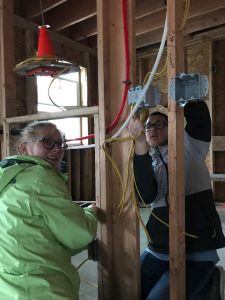
The highlight of the day was meeting our crew and the people who provided our lunch for us. Two workers are AmeriCorps volunteers, which definitely sparked some interest in a couple members of our team today for post-grad plans. Some folks from the neighborhood put together the kindest spread of soups, sandwiches and so much more for us today. No one left without being stuffed to the brim.
We also had the pleasure of meeting a Habitat homeowner named Becca who shared a bit of her story with us. These people helped remind us that the work we are doing, no matter how big or small, is making a difference in someone’s life.
Overall, today has me very excited for the rest of the week. We bonded so much as a group today and met so many wonderful people that I know everyone is looking forward to getting up early and working hard these next few days. North Tillicum is going to look very different in a couple of months.
Erin
By Laurie
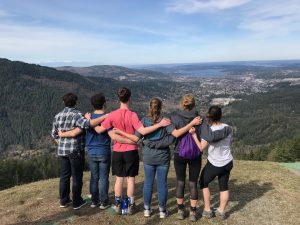 Today was a great day up in Tacoma. We started our day learning more about HFH and all the awesome things they do, as well as talking about the things we wanted to take away from this trip with our new friends Kiara.
Today was a great day up in Tacoma. We started our day learning more about HFH and all the awesome things they do, as well as talking about the things we wanted to take away from this trip with our new friends Kiara.
Next, we headed out with our other new found friend Dan to Tiger Mountain to hike the Poo Poo Trail (Yes, that is the name!). Despite almost not finding a parking spot, we set off to the summit. At the top awaited a breathtaking view of Mount Rainer as well as an overlook over the city of Issaquah and Bellevue.
After completing the trek down, and counting up the total of 47 doggos that we saw along the trail, we headed off to the showers to get cleaned up.
Taking a slight detour after the showers, one of the vans made a pit stop at Safeway to get a surprise birthday cake for Laurie’s birthday. We celebrated Laurie’s birthday, had an amazing dinner, and reflected as a group on how our day went, as well as what we were looking forward to tomorrow. We are excited for our first day on the worksite tomorrow!
Isaac
By Ellie
March 14, 2018
Today’s main focus was Operation Streamline.
Operation Streamline is a federal court preceding that happens every weekday at the federal district court in Tucson where up to 70 immigrants receive prison sentences. They are charged with the felony of re-entry after deportation and the misdemeanor of illegal entry.
Most of the men and women we saw through this process had been caught at the border a few days before their sentence. We sat at the back of the courthouse and watched groups of 6-8 men and women go up, answer a few questions and receive their sentences that varied from 0 to 160 days in privately-owned detention centers.
Watching this process was very difficult for us. The process is usually completed in less than 5 minutes and we could see the confusion in their faces as they walked in with their pre-assigned representatives. These representatives were only given about 30 minutes to speak with their representees; which isn’t enough time to understand the true complexity of their case.
There was one particular client that had a language and education barrier. His attorney informed the judge about the barriers and the judge made an effort to accomodate him but it was still not enough. When asked if he pleaded guilty, he responded “No ma’am, I will not return to your country.” This proved that he was still not fully understanding what was being asked. It was truly heartbreaking seeing the struggle and confusion we saw in this man and many of the other faces.
When they pleaded guilty, we would also hear so much hopelessness in their voices and even fear. After such a long journey only to be detained at the border must have been earth-shattering.
After being sentenced, one of the representatives informed the judge that his client expressed credible fear to return to his country. The judge took note of it but we heard nothing more of the matter. Another man who was sentenced to a detention center mentioned that he had diabetes and required special care. Based on what we have learned, we know there is a small chance this will be taken into consideration.
After watching ths process, the judge took the time to answer some of our questions. Her responses gave us mixed feelings about her attitude towards these immigrants. It was clear that she felt bad for the immigrants but was unwilling to take any of the blame; she believe only Mexico was to blame for the issue.
The rest of the day, we listened to stories of immigrants and their journeys.
By: Karina Diaz and Melissa Olivera
By Ellie
Today we visited the Florence Detention Center which is about an hour and a half away from Borderlinks.
We met a detainee named Milton who spoke to us about his experience in the detention facility as well as what he went through in Ecuador. His reason for coming was to escape the violence that he was a victim of. He came with the hopes and dreams of working in the US and when we asked him what his dreams were, his answer was that he wanted to build a house for his mom with a kitchen, because she doesn’t have one back home.
This was emotional for us because our moms are very important to us and they have done all they can to provide for us and give us a good life. We could see in his face how much he missed her, and it broke our hearts when he said that he couldn’t talk to her as much as he wanted to because it was expensive to make phone calls. Sadly he has been in this detention center for over 2 years and his next court date isn’t until September.
It is sad to know that it has taken this long for him to know if he is even able to get a bond, but he wants to stay and wait out the court proceedings because he really wants to be here and be a productive member of the community. He has no prior criminal record, but he hears from others all the time that he is a criminal and a danger to society, which is frustrating because he is such a good person. Being in detention for so long without knowing exactly what is is going to happen has had a huge effect on his mental and emotional health, but he still has faith and hope, which is amazing and inspiring.
This just goes to show that people in detention facilities are honest, hardworking, and compassionate people who just want the best for themselves and their families. Even those who have done nothing but pursue a better future are treated like they are dangerous or treated like they should be ashamed of wanting a better life. It was an emotional experience, but valuable because it allows us to put a face to the issues that we’ve been talking about throughout the week.
Later that day, we spoke to an attorney with the Florence Defense Project named Valentina. She gave us some information that helped us understand how the system is working and why cases like Milton’s stay in the system for as long as they do. It’s a really complex and broken system, but people Valentina are working step by step to help people and make the system better. This gave us hope knowing that there are people out there making change and that want to do the right thing.
Overall the day was very emotionally draining but we wish that everyone could have this experience. It is easy to dehumanize people and be uncompassionate when you do not know them personally, but when people are in front of you and you can see the emotions in their face as they share their story, it tugs on your heart and makes you want to assist them in any way you can.
Written by Bibiana and Anita
By Ellie
We started the day with a 7-mile trek to the border through a valley in the Coronado National Forest. Our guide Brian from Tucson Samaritans lead us through the rocky/sandy valley.
Along the trek we encountered worn out supplies and used up food and water that the Samaritans had left behind for migrants. During our journey we took breaks to reflect on what traveling across the border for a migrant entails and the hardships they might experience.
Eventually we made it to the border where we saw more food and water drops. Along the trek we stopped briefly to talk and reflect on the things we would see or what our guide Brian would inform us. On our way back to the vans we stopped to have an emotional reflection on what we just experienced.
After that we drove with our guide Leah to the town of Nogales. When we got to Nogales we had the opportunity to meet Manuel, a former undocumented immigrant that like many other came to the US looking for the American Dream. After hearing him talk about how far he’d come in his life we were all in awe of his dedication and attitude.
Then he lead us to a spot along the border wall dividing Nogales, U.S.A. and Nogales, Mexico. Here, Manuel showed us, through the wall, a cross that was painted on the side of a building on the Mexican side. This cross was to mark the death of Jose Antonio Elena Rodriguez who was shot and killed by possibly more than one border patrol agent but only one is being charged.
Manuel then told us the circumstances regarding Elena Rodriguez’s death and the importance since this is the first time a US border patrol agent will be charged (many cases similar to Elena Rodriguez have happened but with no reprecussions).
After that we did this activity with Manuel to show us the Canasta Basica (Basic Basket). We were shown the prices of necessary food and commodities and how difficult it is to get by with the minimum wage salary in Mexico. It really put things into perspective, a person in Mexico needs to work 3 days to earn what it takes an hour the equivalent minimum wage in Oregon can (11.25 USD = 202 MXN).
In preparation for our visitation to the Detention center Florence, we visited Karolina with Mariposas Sin Fronteras. She told us her personal story, the abuse that she went through, how she overcame the adversities in her life, and how she now works to help others that have had similar experiences.
After telling us about her story she told us her future goals and aspirations in her life, her passion inspires us to work for those without a voice. She then proceded to give us guidelines, appropriate behaviors, questions to ask and dress for the detention center which she visits frequently on behalf of Mariposas Sin Fronteras to help as much as she can.
My favorite part of the day was meeting Manuel. With the help of Borderlinks he was able to help Manuel rebuild his life and go from an undocumented immigrant to a visa holder who has a fullfulling life working with borderlinks and living in Mexico.
His attitude was very admirable to say the least and his willingness to participate and teach people as much as he can from his personal expirience, and facts about the complex topic that is immigration, Mexican-US relations and border regulations.
Manuel left us with a quote that said “just because there are a few bad apples doesn’t mean the rest are like that”. He said we are all humans and should treat each other as such and not let bias impair our ability to treat others respectfully.- Paula Ortiz Cazaubon
Personally the hardest part of the day was when Manuel was telling the group about Jose Antonio Elena Rodriguez. We learned that he was shot 14 or 10 times, Mexico coroners say 14 and the United States disputes that claiming 10 times. Either way it seems like way too many times to shoot a 16 year old that was throwing rocks at the border wall.
Additionally, there’s evidence that the bullets came from several different angles. There are several steps that could have been taken to deescalate the situation before the border patrol agents fired. The border wall in Nogales isn’t the average residential wall, it’s at least 20 feet of steel with small slots in the wall.
I’m not entirely sure what constitues an act of war but firing across a border at another country’s citizen seems like it might. It’s also fairly upsetting that this case has been put off since 2012, not to mention all the reported similar cases that never see court.
At the end of all this no amount of justice will bring back Jose Antonio Elena Rodgriuez to his family and friends, nobody will know what he could have done in his life, and that’s awful.
-Dylan Williams